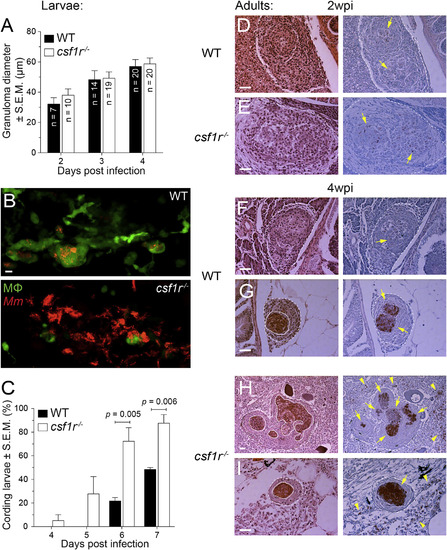Fig. 2
- ID
- ZDB-FIG-150916-17
- Publication
- Pagán et al., 2015 - Myeloid Growth Factors Promote Resistance to Mycobacterial Infection by Curtailing Granuloma Necrosis through Macrophage Replenishment
- Other Figures
- All Figure Page
- Back to All Figure Page
|
Exuberant Mycobacterial Growth in csf1r Mutants Is Associated with Granuloma Necrosis (A) Mean granuloma diameter measured by their longest axis in larvae infected at 2 dpf via the caudal vein with ~195 tdTomato-expressing M. marinum. Data are representative of two sets of injections. (B) Maximum-intensity projections of macrophage-replete WT granuloma or a macrophage-depleted csf1r mutant granuloma showing early signs of cording in 5 dpi mpeg1:YFP larvae infected at 2 dpf via the caudal vein with ~200 tdTomato-expressing M. marinum. Scale bar, 10 µm. (C) Percentage of larvae with cording phenotype after infection with ~190 M. marinum via the caudal vein. Average values from four separate sets of injections from at least two independent experiments were plotted. In (A) and (C), error bars indicate SEM. (D-I) Representative hematoxylin and eosin (left) and modified Ziehl-Neelsen (right) stains of wild-type or csf1r mutant adult zebrafish 2 weeks (D and E) or 4 weeks (F?I) post-intraperitoneal infection with ~100 CFU of M. marinum. Dotted lines delineate granulomas and solid lines indicate regions of necrosis. Arrows indicate mycobacteria inside granulomas and arrowheads indicate mycobacteria outside of granulomas. Scale bars, 50 µm. Two or three fish per group were used for each time point. |
| Gene: | |
|---|---|
| Fish: | |
| Condition: | |
| Anatomical Term: | |
| Stage: | Days 7-13 |

